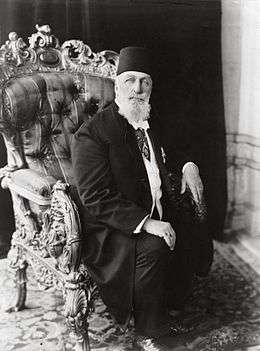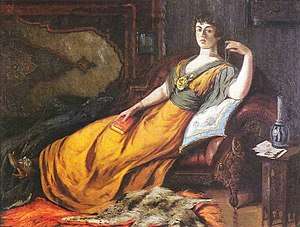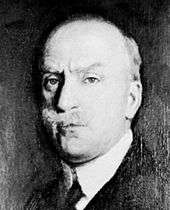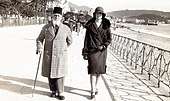Abdulmejid II
Abdulmejid II (Ottoman Turkish: عبد المجید الثانی, romanized: Abdülmecīd-i sāni, Turkish: Halife Abdülmecid Efendi, 29 May 1868 – 23 August 1944) was the last Caliph of Islam of the Ottoman Dynasty, nominally the 37th Head of the Ottoman Imperial House from 1922 to 1924.
| Abdulmejid II | |||||
|---|---|---|---|---|---|
| Ottoman Caliph Amir al-Mu'minin Head of the Ottoman Dynasty | |||||
 | |||||
| 29th Ottoman Caliph | |||||
| Tenure | 19 November 1922 – 3 March 1924 | ||||
| Predecessor | Mehmed VI | ||||
| Successor | Ottoman Caliphate abolished | ||||
| Head of the House of Osman (in exile) | |||||
| Pretence | 16 May 1926 – 23 August 1944 | ||||
| Predecessor | Mehmed VI | ||||
| Successor | Ahmed Nihad | ||||
| Born | 29/30 May 1868[1][2] Beşiktaş, Istanbul, Ottoman Empire | ||||
| Died | 23 August 1944 (aged 76) Paris, France | ||||
| Burial | |||||
| Consorts | Mihrimah Hanım Şehsuvar Hanım Hayrünissa Hanım Mehisti Hanım | ||||
| Issue | Şehzade Ömer Faruk Dürrüşehvar Sultan | ||||
| |||||
| Dynasty | Ottoman | ||||
| Father | Abdulaziz | ||||
| Mother | Hayranidil Kadın | ||||
| Religion | Sunni Islam | ||||
Biography
On 30 May 1868,[1][2] he was born at Dolmabahçe Palace, Beşiktaş, Istanbul, to then Sultan Abdulaziz and his wife Hayranidil Kadın. He was younger full brother of Nazime Sultan. He was educated privately.
In accordance with late Ottoman custom, Abdulmejid was confined to the palace until he was 40. On 4 July 1918, his first cousin Mehmed VI became Sultan and Abdulmejid was named Crown Prince.[1] When his cousin was deposed on 1 November 1922, the Ottoman Sultanate was abolished. But on 19 November 1922, the Crown Prince was elected Caliph by the Turkish National Assembly at Ankara.[1] He established himself in Constantinople[3][4] on 24 November 1922.
On 3 March 1924, six months after the foundation of the Turkish Republic, the Ottoman Caliphate was abolished and the Ottoman dynasty was deposed and expelled from Turkey.[5][6]
Artist

Abdulmejid was given the title of General in the Ottoman Army, but did not have strong military inclinations. He had a more significant role as Chairman of the Ottoman Artists' Society.
He is considered as one of the most important painters of late period Ottoman art. His paintings of the Harem, showing a modern musical gathering, and of his wife, Şehsuvar Hanım, reading Goethe's novel Faust, express the influence of western Europe in his elite circle.[7] These were displayed at a 1918 exhibition of Ottoman paintings in Vienna. His personal self-portrait can be seen at Istanbul Modern.
Abdulmejid was also an avid collector of butterflies, an activity that he pursued during the last 20 years of his life. His favourite magazine was Revue des deux Mondes.[7]
Death
On 23 August 1944, Abdulmejid II died at his house in the Boulevard Suchet, Paris. His death coincided with the Liberation of Paris from the German occupation. He was buried in Medina by the recommendation of King Saud of Saudi Arabia.
Family



- Consorts
Abdulmejid had four consorts:
- Mihrimah Hanım (died at Nakkaştepe Palace, 23 May 1899, buried in Nuhkuyusu Mosque, Istanbul);[8]
- Şehsuvar Hanım (m. Ortaköy Palace, 23 December 1896; Istanbul, 2 May 1881 – Paris, 1945, buried there at Bobigny cemetery);
- Hayrünissa Hanım[9] (m. Ortaköy Palace, 18 June 1902; Bandırma, c. 1877 – Nice, 3 September 1936);
- Mehisti Hanım (m. Çamlıca Palace, 16 April 1912, Adapazarı, c. 1896 – London, Middlesex, 1964, buried in Brookwood cemetery), daughter of Akalsba Hacımaf Bey, and Safiye Hanım;
- Son
- Şehzade Ömer Faruk (Constantinople, Ortaköy, Ortaköy Palace, 27 February 1898 – 28 March 1969/1971) - with Şehsuvar, married firstly at Yıldız Palace on 29 April 1920 to his second cousin Sabiha Sultan (Constantinople, Ortaköy, Ortaköy Palace, 19 March/1 April 1894 – Istanbul, 26 August 1971), and had three daughters, and married secondly in İskenderiye on 31 July 1948 to his cousin Mihrişah Sultan (Constantinople, Beşiktaş, Beşiktaş Palace, 1 June 1916 – Istanbul, 25 January 1987), without issue:
- Fatma Neslişah Osmanoğlu Sultan (Constantinople, Nişantaşı, Nişantaşı Palace, 4 February 1921 – 1 April 2012), married in Heliopolis Palace, Cairo, on 26 September 1940 to her cousin Damat Prince Muhammad Abdel Moneim (Alexandria, Montaza Palace, 20 February 1899 – Istanbul, 1/2 December 1979, buried in Cairo), heir apparent to the throne of Egypt from 1899 to 1914, created HH in 1922, created HRH in 1952, Regent of Egypt from 1952 to 1953, and had issue
- Zehra Hanzade Sultan (Constantinople, Dolmabahçe Palace, 12 September 1923 – Paris, 19 March 1998, buried on 26 March 1998), married in Cairo in September 1940 to Damat Prince Muhammad Ali Ibrahim (Cairo, 29 April 1900 – Paris, 2 July 1977), and had issue:
- Nabila Sabiha Fazila Ibrahim Hanımsultan (b. Neuilly-sur-Seine, 8 August 1941), was the fiance of King Faisal II of Iraq until 1958 when the king was killed. Few years later she married Kheri Oglu, together they had two sons Ali and Saleem
- Nabil Sultanzade Ahmad Rifat Ibrahim (b. 31 August 1942), married on 26 June 1969 to Emine Ushakidil, without issue
- Necla Heybetullah Sultan (Nice, 15 May 1926 – 16 October 2006), married in Cairo in February 1943 to Nabil Amr Ibrahim (Cairo, 18 April 1903 – 1977), and had issue:
- Nabil Sultanzade Osman Rifat Ibrahim (b. 20 May 1951), unmarried and without issue
- Daughter
- Hatice Hayriye Ayşe Dürrüşehvar Sultan (Constantinople, Üsküdar, Çamlıca Palace, 26 January 1914 – 7 February 2006) - with Mehisti, married in Nice on 12 November 1931 to Damat Walashan Nawab Sir Mir Himayat Ali Khan Azam Jah Bahadur (22 February 1907 – 9 October 1970), Prince of Berar, son of the last Nizam of Hyderabad India, and had issue.
Ancestry
| Ancestors of Abdulmejid II | |||||||||||||||||||||||||||||||||||||||||||||||||||||||||||||||||||||||||||||||||||||||||||||||||||||||||||||||||||||||||||||||||||||||||||||||||||||||||||||||||||||||||||||||||||||||||||||||||||||||||||||||||||||||||||||||||||||||||||||||||||||||||||||||||||||||||||||||||||||||||||||||||||||||||||||||||||||||||||||||||||||||||||||||||||||||||||||||||||||||||||||||||||||||||||||||||||||||||||||||||||||||||||||||||||||||||||||||||||||||||||||||||||||||||||||||||||
|---|---|---|---|---|---|---|---|---|---|---|---|---|---|---|---|---|---|---|---|---|---|---|---|---|---|---|---|---|---|---|---|---|---|---|---|---|---|---|---|---|---|---|---|---|---|---|---|---|---|---|---|---|---|---|---|---|---|---|---|---|---|---|---|---|---|---|---|---|---|---|---|---|---|---|---|---|---|---|---|---|---|---|---|---|---|---|---|---|---|---|---|---|---|---|---|---|---|---|---|---|---|---|---|---|---|---|---|---|---|---|---|---|---|---|---|---|---|---|---|---|---|---|---|---|---|---|---|---|---|---|---|---|---|---|---|---|---|---|---|---|---|---|---|---|---|---|---|---|---|---|---|---|---|---|---|---|---|---|---|---|---|---|---|---|---|---|---|---|---|---|---|---|---|---|---|---|---|---|---|---|---|---|---|---|---|---|---|---|---|---|---|---|---|---|---|---|---|---|---|---|---|---|---|---|---|---|---|---|---|---|---|---|---|---|---|---|---|---|---|---|---|---|---|---|---|---|---|---|---|---|---|---|---|---|---|---|---|---|---|---|---|---|---|---|---|---|---|---|---|---|---|---|---|---|---|---|---|---|---|---|---|---|---|---|---|---|---|---|---|---|---|---|---|---|---|---|---|---|---|---|---|---|---|---|---|---|---|---|---|---|---|---|---|---|---|---|---|---|---|---|---|---|---|---|---|---|---|---|---|---|---|---|---|---|---|---|---|---|---|---|---|---|---|---|---|---|---|---|---|---|---|---|---|---|---|---|---|---|---|---|---|---|---|---|---|---|---|---|---|---|---|---|---|---|---|---|---|---|---|---|---|---|---|---|---|---|---|---|---|---|---|---|---|---|---|---|---|---|---|---|---|---|---|---|---|---|---|---|---|---|---|---|---|---|---|---|---|---|---|---|---|---|---|---|---|---|---|---|---|---|---|---|---|---|---|---|---|---|---|---|---|---|---|---|---|---|---|---|---|---|---|---|---|---|---|---|---|---|---|---|---|---|---|---|---|---|---|---|---|---|---|---|---|---|---|---|---|---|---|---|---|---|---|---|---|---|---|
| |||||||||||||||||||||||||||||||||||||||||||||||||||||||||||||||||||||||||||||||||||||||||||||||||||||||||||||||||||||||||||||||||||||||||||||||||||||||||||||||||||||||||||||||||||||||||||||||||||||||||||||||||||||||||||||||||||||||||||||||||||||||||||||||||||||||||||||||||||||||||||||||||||||||||||||||||||||||||||||||||||||||||||||||||||||||||||||||||||||||||||||||||||||||||||||||||||||||||||||||||||||||||||||||||||||||||||||||||||||||||||||||||||||||||||||||||||
References
- Hoiberg, Dale H., ed. (2010). "Abdümecid II". Encyclopædia Britannica. I: A-ak Bayes (15th ed.). Chicago, Illinois: Encyclopædia Britannica Inc. pp. 23. ISBN 978-1-59339-837-8.
- There are sources that give the 29th as the day of his birth.
- The Encyclopædia Britannica, Vol.7, Edited by Hugh Chisholm, (1911), 3; Constantinople, the capital of the Ottoman Empire...
- Inc, Encyclopaedia Britannica (1 May 2008). Britannica Concise Encyclopedia. Encyclopaedia Britannica, Inc. p. 966. ISBN 9781593394929.
- Finkel, Caroline (2007). "Osman's Dream: The History of the Ottoman Empire". Basic Books. p. 546. ISBN 9780465008506.
- Özoğlu, Hakan (2011). From Caliphate to Secular State: Power Struggle in the Early Turkish Republic. ABC-CLIO. p. 6. ISBN 9780313379567.
- "The Ottoman caliphate: Worldly, pluralist, hedonistic—and Muslim, too". The Economist. 19 December 2015. Retrieved 26 December 2015.
- Haskan, Mehmet Nermi (2001). Yüzyıllar boyunca Üsküdar - Volume 1. Üsküdar Belediyesi. p. 298. ISBN 978-9-759-76062-5.
- Bardakçı, Murat (2017). Neslishah: The Last Ottoman Princess. Oxford University Press. p. 110. ISBN 978-9-774-16837-6.
See also
- Line of succession to the former Ottoman throne
External links
Abdulmejid II House of Osman Born: 29 May 1868 Died: 23 August 1944 | ||
| Sunni Islam titles | ||
|---|---|---|
| Preceded by Mehmed VI |
Last Caliph of the Ottoman Caliphate 19 November 1922 – 3 March 1924 |
Vacant |
| Titles in pretence | ||
| Preceded by Mehmed VI |
— TITULAR — Sultan of the Ottoman Empire 19 November 1922 – 23 August 1944 Reason for succession failure: Empire abolished in 1922 |
Succeeded by Ahmed Nihad |
| — TITULAR — Caliph of the Ottoman Caliphate 3 March 1924 – 23 August 1944 Reason for succession failure: Caliphate abolished on March 3, 1924 |
Vacant Caliphate abolished in 1924 (The religious position and the official representation of the caliph's powers was transferred to Diyanet İşleri Başkanlığı) | |
